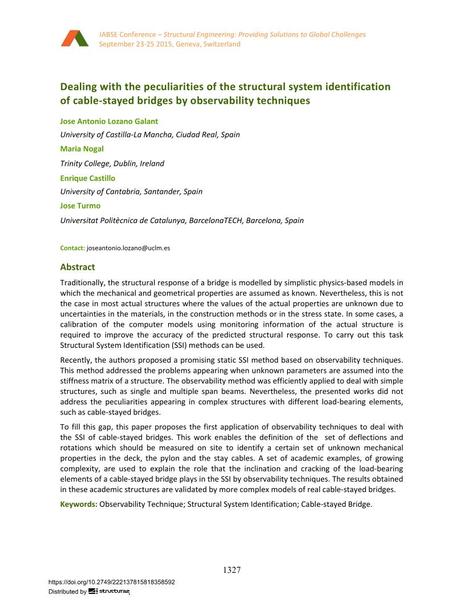Dealing with the peculiarities of the structural system identification of cable-stayed bridges by observability techniques

|
|
|||||||||||
Bibliographic Details
| Author(s): |
Jose Antonio Lozano Galant
(University of Castilla-La Mancha, Ciudad Real, Spain)
Maria Nogal (Trinity College, Dublin, Ireland) Enrique Castillo (University of Cantabria, Santander, Spain) José Turmo |
||||
|---|---|---|---|---|---|
| Medium: | conference paper | ||||
| Language(s): | English | ||||
| Conference: | IABSE Conference: Structural Engineering: Providing Solutions to Global Challenges, Geneva, Switzerland, September 2015 | ||||
| Published in: | IABSE Conference Geneva 2015 | ||||
|
|||||
| Page(s): | 1327-1333 | ||||
| Total no. of pages: | 7 | ||||
| Year: | 2015 | ||||
| DOI: | 10.2749/222137815818358592 | ||||
| Abstract: |
Traditionally, the structural response of a bridge is modelled by simplistic physics-based models in which the mechanical and geometrical properties are assumed as known. Nevertheless, this is not the case in most actual structures where the values of the actual properties are unknown due to uncertainties in the materials, in the construction methods or in the stress state. In some cases, a calibration of the computer models using monitoring information of the actual structure is required to improve the accuracy of the predicted structural response. To carry out this task Structural System Identification (SSI) methods can be used. Recently, the authors proposed a promising static SSI method based on observability techniques. This method addressed the problems appearing when unknown parameters are assumed into the stiffness matrix of a structure. The observability method was efficiently applied to deal with simple structures, such as single and multiple span beams. Nevertheless, the presented works did not address the peculiarities appearing in complex structures with different load-bearing elements, such as cable-stayed bridges. To fill this gap, this paper proposes the first application of observability techniques to deal with the SSI of cable-stayed bridges. This work enables the definition of the set of deflections and rotations which should be measured on site to identify a certain set of unknown mechanical properties in the deck, the pylon and the stay cables. A set of academic examples, of growing complexity, are used to explain the role that the inclination and cracking of the load-bearing elements of a cable-stayed bridge plays in the SSI by observability techniques. The results obtained in these academic structures are validated by more complex models of real cable-stayed bridges. |
||||
| Keywords: |
cable-stayed bridge structural system identification Observability Technique
|
||||

